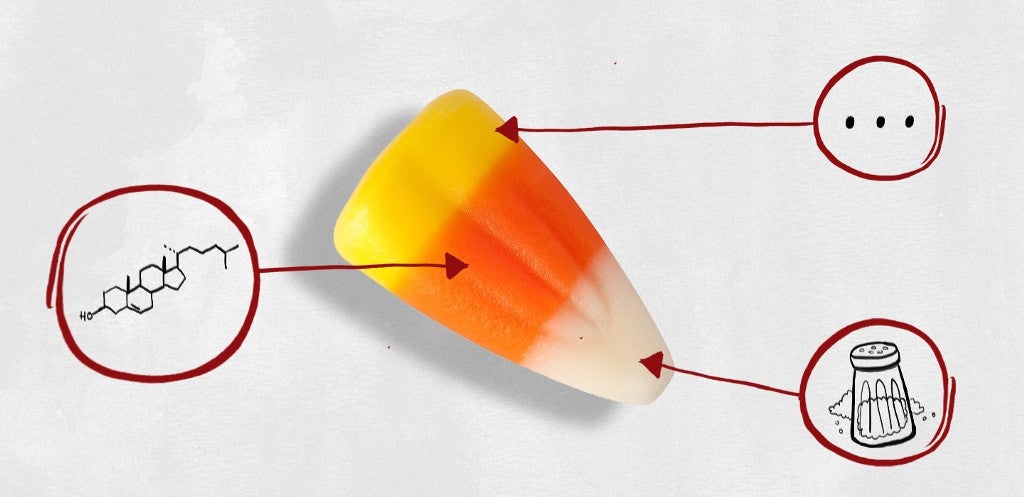We’re often told that you should never eat anything (or put anything on your body) if you don’t recognize everything on the ingredients list. But since most of us have no idea what xanthan gum or potassium benzoate are — or more importantly, what they’re doing to our bodies — we’re decoding the ingredients in the many things Americans put in (and on) themselves with the help of an expert.
This edition: Brach’s Candy Corn, which is made from 12 separate ingredients that we’ve broken down in the exact order they appear on their website.

The Ingredients
1) Sugar: A single serving (19 pieces) of Brach’s Candy Corn contains a whopping 28 grams of sugar, which lands near the recommended daily intake. The American Heart Association recommends men consume no more than 36 grams and women consume no more than 25 grams of added sugar a day (that doesn’t even include sugar found naturally in foods like fruits and vegetables). Too much sugar, if you didn’t already know, is terrible for you: A sugar-laden diet is associated with all kinds of ailments, from heart disease to depression. But then, this is candy — what did you expect? Actual corn? Speaking of which…
2) Corn Syrup: Corn syrup is a liquid sweetener made of glucose. It doesn’t get as much negative publicity as high-fructose corn syrup — which has been linked to obesity and diabetes by many, many studies (more on that here) — but regular corn syrup isn’t great either, considering it’s basically liquid sugar. And as we’ve already learned, too much sugar is bad news.
3) Confectioner’s Glaze: Confectioner’s glaze is made primarily of shellac, a resin secreted by certain insects in India and Thailand (no, really). It’s commonly used as a candy coating, since it adds a shiny sheen that protect the products from moisture exposure. It won’t do you any harm, but again: It’s bug goo.
4) Salt: This is probably added as a flavor enhancer and mild preservative.
5) Dextrose: Dextrose is a sugar derived from starches, like corn. Fun fact: Dextrose has a high glycemic index, meaning it quickly raises the blood sugar levels, so it’s used in IV solutions to treat low blood sugar and dehydration. People with diabetes might also consume dextrose tablets to raise their blood sugar levels if they become dangerously low. Because of this blood-sugar-boosting effect, consuming dextrose also provides an almost immediate jolt of energy — then the inevitable crash.
6) Gelatin: Gelatin is a colorless, flavorless protein derived from various animal parts, so vegetarians and vegans beware. It’s commonly used as a gelling agent, and it’s what makes up the bulk of candy corn.
7) Sesame Oil: Sesame oil has a nutty and slightly sweet flavor, and unlike most vegetable oils, it’s actually pretty healthful: Studies show that sesame oil has anti-inflammatory and antioxidant properties and can ward off high cholesterol.
8) Artificial Flavor: Artificial flavors are chemical compounds created in a lab that mimic a natural flavor in some way. While that may sound unnatural (and therefore, unhealthy), physician and biochemist Cate Shanahan, author of Deep Nutrition: Why Your Genes Need Traditional Food, has no real problem with artificial flavors. As she explained to us in our exploration of all 26 ingredients in nacho-flavored Doritos: “They’re not killers because they’re added in very, very small quantities to food.”
9) Honey: This is added for sweetness (surprise!).
10, 11 & 12) Yellow 6, Yellow 5 and Red 3: Similar to artificial flavors, artificial colors are created in a lab by chemists. Unfortunately, they’re known to be carcinogenic: “Because color molecules are a similar shape to some of our DNA structures, they’re able to make their way in there and cause issues,” Shanahan explains. “That said, I’ve always been of the opinion that studies claiming artificial colors can cause cancer are irrelevant because [in the studies] they use really high amounts of the artificial colors — like, a million times more than you’d ever get [in your] food [throughout your lifetime].” So the average person’s liver should be able to break down whatever minuscule amount of artificial coloring we consume with food.

The Takeaway
Your biggest concern when tossing candy corn after candy corn into your mouth should be the amount of sugar they contain. Did we mention too much sugar is bad for you? And while you probably already knew this — it is candy, after all — candy corn should be consumed in moderation.
Or, you know, not at all. Because it’s gross.

